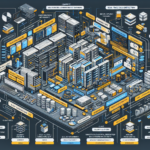Implementing IT infrastructure for big data processing requires careful planning to ensure scalability, reliability, and performance. Below is a step-by-step guide tailored for an IT manager responsible for datacenters, storage, servers, virtualization, and related infrastructure:
1. Assess Business Requirements
- Determine the volume, variety, and velocity of data you’ll be processing (the 3 Vs of big data).
- Understand the use case: analytics, real-time processing, machine learning, AI, etc.
- Define key performance indicators (KPIs) for your infrastructure (e.g., processing speed, uptime, scalability).
2. Core Infrastructure Design
a. Compute
- Servers: Use high-performance servers with multi-core CPUs and large memory capacity.
- GPU Cards: For AI and machine learning workloads, deploy GPU-enabled servers (e.g., NVIDIA A100, H100, or similar).
- Virtualization: Use hypervisors (VMware, Hyper-V) or container platforms (Docker, Kubernetes) to optimize compute utilization.
b. Storage
- Types: Implement a mix of storage types:
- Object Storage (e.g., S3, Ceph) for unstructured data.
- Block Storage (e.g., SAN or NVMe drives) for high-performance needs.
- HDFS: Use Hadoop Distributed File System for distributed data processing.
- Capacity: Plan for scalability, starting with petabytes if necessary.
- Backup: Establish a robust backup and disaster recovery strategy (e.g., using Veeam, Commvault).
c. Networking
- High-Speed Connectivity: Use 10GbE, 40GbE, or 100GbE network interfaces for fast data transfer between nodes.
- Switches: Deploy high-performance switches with low-latency capabilities.
- Security: Use firewalls, VLANs, and network segmentation to secure data.
d. Virtualization and Orchestration
- Deploy Kubernetes clusters for containerized big data workloads. Tools such as Rancher or OpenShift can simplify Kubernetes management.
- Use Docker for containerization if needed.
3. Big Data Frameworks
Install and configure big data frameworks depending on your use case:
– Batch Processing: Hadoop, Apache Spark.
– Streaming: Apache Kafka, Apache Flink.
– Data Storage: MongoDB, Cassandra, Elasticsearch.
– Data Warehousing: Snowflake, Google BigQuery, Amazon Redshift.
4. AI and Machine Learning
If AI is a component of your big data processing:
– Deploy GPU servers (e.g., NVIDIA CUDA-enabled systems).
– Use frameworks like TensorFlow, PyTorch, or RAPIDS for accelerated data processing.
– Ensure Kubernetes GPU scheduling is enabled for containerized ML workloads.
5. Cloud Integration
- Hybrid Approach: Combine on-premise infrastructure with cloud services (AWS, Azure, or Google Cloud) for scalability.
- Data Lake: Use cloud-based data lakes for easy storage and processing of large datasets.
- Cost Optimization: Implement tools like AWS Cost Explorer or Azure Cost Management to monitor expenses.
6. Automation
- Use Infrastructure as Code (IaC) tools like Terraform or Ansible to automate provisioning and configuration.
- Monitor and manage workloads using tools like Prometheus and Grafana for real-time insights.
7. Security
- Implement role-based access control (RBAC) for data and infrastructure.
- Use encryption for data at rest and in transit.
- Ensure compliance with regulations (GDPR, HIPAA, etc.) as necessary.
8. Monitoring and Optimization
- Use monitoring tools such as Nagios, Zabbix, or Datadog for infrastructure health.
- Optimize resource utilization with tools like Kubernetes Horizontal Pod Autoscaler.
- Conduct periodic performance tests to ensure your infrastructure meets requirements.
9. Scalability
- Design the architecture to scale horizontally (add more nodes) and vertically (upgrade existing nodes).
- Use container orchestration to dynamically scale workloads based on demand.
10. Team and Skills
- Ensure your team is skilled in big data frameworks, Kubernetes, storage systems, and cloud technologies.
- Provide training on emerging technologies such as AI/ML frameworks and GPU acceleration.
11. Backup and Disaster Recovery
- Implement a backup solution for big data, using tools like Veeam, Rubrik, or CommVault.
- Design disaster recovery strategies to ensure business continuity.
Example Architecture:
- Compute: High-performance servers with GPUs for AI workloads.
- Storage: Distributed file systems (HDFS, Ceph) and object storage (S3 compatible).
- Networking: High-bandwidth, low-latency connections.
- Frameworks: Hadoop for batch processing, Kafka for streaming, Spark for real-time analytics.
- Orchestration: Kubernetes for containerized application scaling.
Tools and Technologies:
Big Data Frameworks
- Apache Hadoop, Spark, Kafka, Flink, Cassandra, MongoDB.
AI Frameworks
- TensorFlow, PyTorch, RAPIDS, Keras.
Cloud Providers
- AWS, Azure, Google Cloud.
Monitoring
- Prometheus, Grafana, Zabbix, Datadog.
Backup
- Veeam, Commvault, Rubrik.
Final Thoughts:
Big data processing infrastructure must be designed for high scalability, reliability, and security. Stay up-to-date on emerging technologies like GPU acceleration, AI frameworks, and Kubernetes advancements to ensure your infrastructure remains future-proof.




